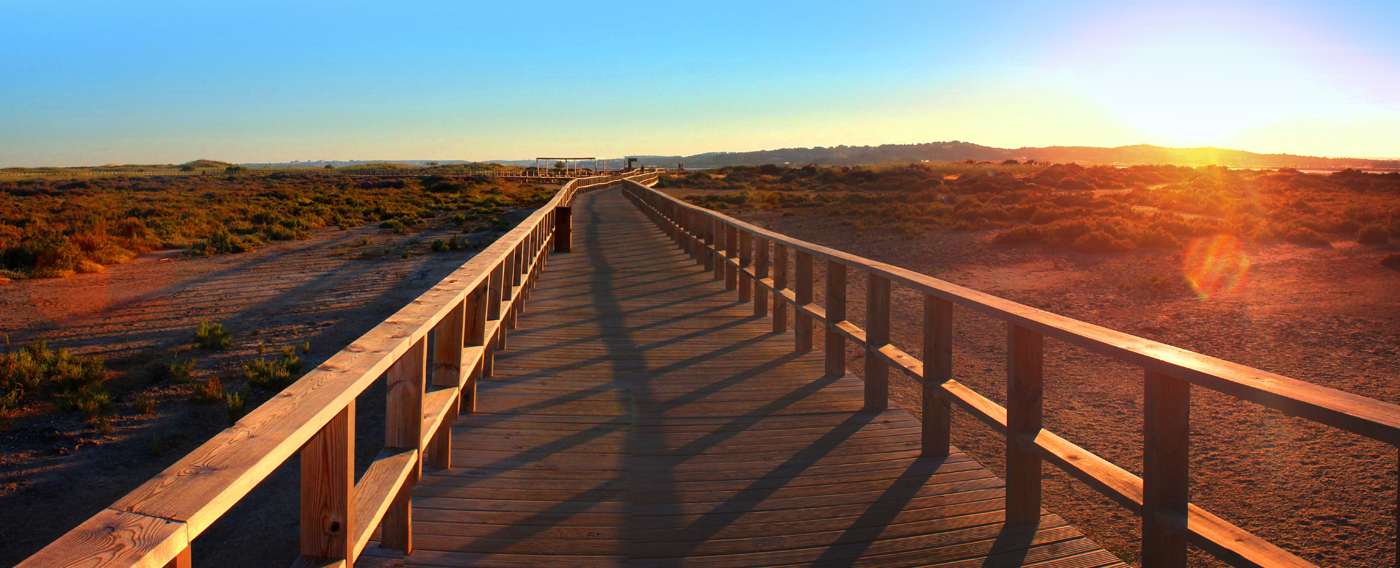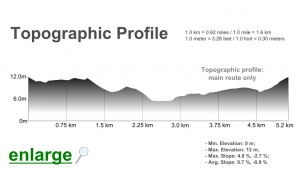
TRAIL FACTSHEET
ALVOR | BIRDS & NATURE: PLEASE SEE HERE
Location: Alvor village; Portimão municipality; GPS Coordinates (decimal degrees): 37.126415 N, -8.596040 W; Grade: easy; Type: loop trails; signposted paths; Lenght: about 5200 meters / 3.2 miles; boardwalk only: about 3.0 kilometers / 1.9 miles; Average Completion Time: 45 minutes – 2 hours, depending on the chosen route; Best Time to Visit: all year-round; Activities: nature walks; cycling; running; birding;
This extensive wooden structure starts its winding course by the little harbour, right alongside the fishermen’s huts. It then takes you through estuarine wetlands and shallow blue lagoons. A drowned valley formed by the confluence of four different small rivers, the charming estuary is one of the most significant wetland refuges in southern Portugal. The assortment of distinct habitats makes it possible to observe a significant number of marine birds, like the Caspian Tern (Sterna caspia), as well as waders and long-legged species, such as the Greater Flamingo (Phoenicopterus roseus) and the Stone-curlew (Burhinus oedicnemus), as well as birds that prefer to inhabit marshes or even farmland, like the Hoopoe and the Bluethroat (Luscinia svecica: pictured below on the left). Waterfowl is especially abundant during the annual autumn and spring migrations (please see Algarve Birding Hotspots for details). Spring, and some of the migrating birds, turn up very early in the Algarve.
Adding yet another layer of colour to the surroundings, in late January many plants start to blossom. Along the salt marsh, you’ll clearly distinguish the so-called ‘vegetation zonation’, whereby each different species of salt marsh plant occupies a very specific ecological niche – in the higher marsh levels, away from the tidal flooding, you might observe the purple Limoniastrum flowers; in the lower levels, Small Cordgrass (Spartina maritima) populates the cyclically flooded mudflats; in between them you might observe the bright yellow, bizarre-looking Yellow Broomrape (Cistanche phelypaea). The best periods to visit the estuary are early morning or just before the sunset, a time when a sense of peacefulness and intimacy surrounds the whole landscape.
 It is a watery scenery in continuous, albeit languid, transformation: the gorgeous views and smooth natural colours gradually change with the ambient light, the weather patterns, the multicoloured wildflowers, and the prevailing tide. Strolling on the boardwalk, far to the north you’ll clearly discern the verdant Monchique massif silhouetted against the horizon; a bit to the south, hidden by the unspoilt dunes, there’s Lagos Bay; meanwhile, you´ll contemplate the ever changing shades of blue and green along the secluded inner lagoon, as well as beautiful Rocha Delicada (a name meaning ‘Delicate’ or ‘Elegant Rock’), an ochre promontory formed during the Miocene (23 to 5.3 Million Years Ago), a long-gone epoch when strange extinct mammals, such as some giant bears and three-toed midget horses, used to roam this stretch of land. Embedded in its calcareous rock face it is possible to detect some marine fossils mainly composed of oyster, scallop, and clam specimens.
It is a watery scenery in continuous, albeit languid, transformation: the gorgeous views and smooth natural colours gradually change with the ambient light, the weather patterns, the multicoloured wildflowers, and the prevailing tide. Strolling on the boardwalk, far to the north you’ll clearly discern the verdant Monchique massif silhouetted against the horizon; a bit to the south, hidden by the unspoilt dunes, there’s Lagos Bay; meanwhile, you´ll contemplate the ever changing shades of blue and green along the secluded inner lagoon, as well as beautiful Rocha Delicada (a name meaning ‘Delicate’ or ‘Elegant Rock’), an ochre promontory formed during the Miocene (23 to 5.3 Million Years Ago), a long-gone epoch when strange extinct mammals, such as some giant bears and three-toed midget horses, used to roam this stretch of land. Embedded in its calcareous rock face it is possible to detect some marine fossils mainly composed of oyster, scallop, and clam specimens.
Shellfish remains quite abundant in Alvor. That is why shellfish catchers are also a common sight in the estuary, patiently practicing a time-honoured craft that makes sure you’ll always eat the most delicious seafood the Algarve has to offer. Before turning back along the vegetated dunes, the boardwalk will take you right to the point where the lagoon finally meets the ocean. By then, the main path has led you to the far-end of the spacious Alvor beach. At that point, the boardwalk reaches a breakwater topped by a small lighthouse. Looking to the water, it is sometimes possible to distinguish large shoals of silvery fish: good-looking (and probably great-tasting) fish, you might think to yourself. After such a pleasant walk, you’ll probably need to please your appetite as well. Head back to the village and find a traditional bistro. The savoury-looking fish you were longing to taste will be there waiting for you, handsomely grilled.
There are several places to park your car near the beach and along the waterfront. The parking lot displayed on the map above is the closest to the boardwalk. The walk can be as long or as short as you wish, since the boards meander off in different directions; resting areas are provided along the walkway. The Alvor Boardwalk & Estuary Trail does not follow the boardwalk exactly – it combines the boardwalk with a beach walk. On warmer days take plenty of water, since there are no bars or cafés at the end of the walkway. Avoid walking long stretches between 11 a.m. and 3 p.m. in July and August. Some months, however, might be very windy – in winter, do not forget to bring warm clothes; also, wearing trainers (and not flip-flops) is advisable. The boardwalk is suitable for wheelchairs, pushchairs/prams and bicycles. Cars, and all other motorized vehicles, as well as dogs, are not allowed. The broad beaches offer excellent swimming opportunities, but swimmers should avoid the hazardous tidal currents near the ocean inlet. Use insect repellent if you plan to walk at early morning or at sunset. Usually, mosquitoes are not an issue between November and February. Enjoy!
